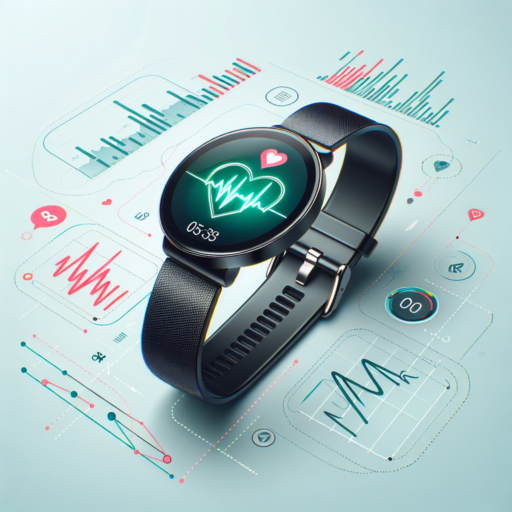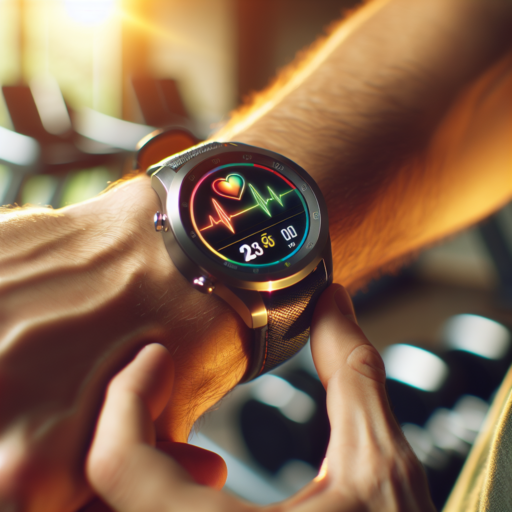What is a Wearable Pulse Rate Monitor?
A Wearable Pulse Rate Monitor is a sophisticated piece of technology designed to track and display the wearer’s heart rate in real-time. This small, but mighty device can be worn on various parts of the body such as the wrist, chest, or even as an earbud. Its primary function is to monitor the pulsations of the heart to provide instantaneous feedback on physical exertion levels, overall heart health, and fitness progress.
These monitors work by using optical sensors or electrical impulses to detect the heart rate. The most common type, found in smartwatches and fitness bands, utilizes optical technology. It shines a light on the skin and measures the variation in blood flow. On the other hand, chest strap models use electrical signals to pick up the heart’s activity, often providing more accurate readings. This allows athletes, fitness enthusiasts, and individuals monitoring their health for medical reasons to gain valuable insights into their cardiovascular performance and well-being.
The rise of wearable technology has made pulse rate monitors widely accessible and convenient for everyday use. From helping runners measure their pacing to aiding in recovery tracking for cardiac patients, these devices play a pivotal role in modern health and fitness regimes. Their ability to connect with smartphones and other gadgets also means that users can store, analyze, and even share their health data, contributing to a more informed and health-conscious society.
Top Features to Look for in a Wearable Pulse Rate Monitor
When it comes to maintaining your health and optimizing your fitness routine, a wearable pulse rate monitor can be a game-changer. These devices provide invaluable insights into your heart’s health, helping you to adjust your workouts for maximum efficiency. However, with a variety of options available on the market, it is crucial to know which features make the most significant impact on your fitness journey.
Accuracy and Reliability
The cornerstone of a top-quality wearable pulse rate monitor is its accuracy and reliability. An ideal device should offer precise measurements of your pulse rate, ensuring that you can trust the data to make informed decisions about your health and fitness. Look for monitors that have been validated against clinical standards, as accuracy in pulse rate detection can considerably differentiate between an average device and an exceptional one.
Real-Time Monitoring and Alerts
A feature that enhances the usability of a pulse rate monitor is real-time monitoring coupled with immediate alerts. This functionality is pivotal for users who need to keep a close eye on their heart rate during vigorous activities or for those with specific health conditions. Monitors that provide instant feedback and alerts when your pulse exceeds or drops below personalized thresholds can be lifesavers, helping you to avoid potential health risks.
Connectivity and App Integration
In the age of technology, the capacity for a wearable pulse crisis monitor to connect seamlessly with your smartphone or other devices adds an extra layer of convenience and functionality. This interoperability allows for a comprehensive analysis of your heart rate data over time, enabling you to track progress, identify trends, and adjust your health and fitness goals accordingly. Choosing a monitor that offers strong connectivity and app integration is essential for anyone looking to take a data-driven approach to their well-being.
The Benefits of Using a Wearable Pulse Rate Monitor
Wearable pulse rate monitors have become a staple in the realm of fitness and health monitoring, offering numerous advantages for individuals seeking to maintain or improve their health. These devices, designed for continuous tracking, allow users to gain real-time insights into their heart rate, a critical indicator of overall cardiovascular health. By providing immediate feedback, wearable pulse rate monitors play an essential role in exercise management and health awareness.
One of the key benefits of using a wearable pulse rate monitor is its ability to enhance workout efficiency. By enabling users to track their heart rate in real time, individuals can adjust their exercise intensity to remain within their target heart rate zones. This ensures that they are not overexerting themselves, which can lead to injury, or underperforming, which may minimize the effectiveness of their workout. Additionally, tracking heart rate over time can help in identifying fitness progress and in tailoring workouts to meet specific fitness goals.
Furthermore, wearable pulse rate monitors offer significant advantages in monitoring overall health. Beyond just exercise, these devices provide valuable insights into one’s daily heart rate variability, which can indicate stress levels, sleep quality, and other important health indicators. By keeping an eye on these metrics, individuals can make informed decisions about lifestyle adjustments to improve their health and well-being. Moreover, for those with cardiovascular concerns or conditions, having continuous access to heart rate data can be crucial for managing health under medical guidance.
How Does a Wearable Pulse Rate Monitor Work?
Understanding how a wearable pulse rate monitor works involves looking into the technology that makes tracking our heart’s rhythm and pace possible in real-time. Primarily, these devices employ photoplethysmography (PPG) technology, a non-invasive method that uses a light source and a photodetector at the surface of the skin to measure the rate at which blood is pumped through the body’s veins. This data gives us insights into our heart rate, an essential metric for monitoring overall health and determining the intensity of a workout.
The process starts when the device emits a green LED light that penetrates the skin and is absorbed by the blood. As the heart beats, the volume of blood flowing through the veins varies, causing changes in the absorption of this light. The photodetector tracks these fluctuations and, through sophisticated algorithms, converts the information into electrical signals. These signals are then analyzed to provide a real-time reading of the wearer’s pulse rate on the device’s display or companion app. It’s this precise and non-invasive nature that makes wearable pulse rate monitors popular among athletes, fitness enthusiasts, and individuals needing to keep a close check on their heart’s health.
The accuracy of these devices, while remarkable, can be affected by several factors such as device placement, skin tone, and motion intensity. Manufacturers continually work to improve the algorithms and sensor sensitivity to mitigate these challenges, ensuring that users get reliable and consistent readings. Wearable pulse rate monitors have become indispensable tools for anyone looking to optimize their health and fitness regime, offering a blend of convenience, efficiency, and insightful data to guide their journey towards well-being.
Comparing Wearable Pulse Rate Monitors: Watches vs. Bands vs. Clips
When navigating the evolving market of wearable pulse rate monitors, consumers are presented with a variety of options, each catering to different lifestyles and requirements. Three of the most popular categories today are smartwatches, fitness bands, and clip-on devices. The choice between watches, bands, and clips often comes down to personal preference and intended use, yet understanding the distinctions can significantly enhance user experience and satisfaction.
Smartwatches, often regarded as the most multifunctional choice, offer not only pulse rate monitoring but also a wide array of features such as smartphone notifications, GPS, and even mobile payment options. The appeal of smartwatches lies in their versatility, making them an excellent option for those seeking a comprehensive health and fitness tracker that integrates seamlessly into everyday life. However, this sophistication comes at a higher price point and with a more significant demand on daily or frequent charging.
Fitness bands, in contrast, typically focus on health and exercise metrics, including heart rate monitoring, steps, and sleep tracking. They are generally more streamlined and less obtrusive than smartwatches, offering a simpler user interface and longer battery life. Fitness bands are an ideal choice for individuals who prioritize the tracking of their physical activities and health-related metrics without the need for additional smart features. Their affordability and durability make them particularly appealing to the avid exerciser or anyone interested in monitoring their health metrics without additional bulk or complexity.
Lastly, clip-on devices provide a unique blend of discreteness and functionality. These monitors can be clipped onto clothes or a belt and are especially convenient for those who prefer not to wear anything on their wrists. While they offer similar tracking capabilities to bands and watches, clip-on monitors are particularly noted for their convenience and unobtrusiveness, often being the go-to choice for individuals seeking minimalism in their fitness tracking experience. Despite their compact form, they can be limited in features compared to their wrist-worn counterparts.
Setting Up Your Wearable Pulse Rate Monitor for Accurate Readings
Ensuring that your wearable pulse rate monitor provides accurate readings is crucial for heart rate monitoring, fitness tracking, and overall health management. The initial setup of your device is a pivotal step that can significantly impact its precision and reliability. Here, we delve into key considerations and steps for setting up your wearable pulse rate monitor to ensure you’re getting the most accurate readings possible.
Choosing the Right Fit
The fit of your wearable pulse rate monitor plays a vital role in the accuracy of the readings. A device that’s too loose may fail to detect your pulse effectively, while one that’s too tight can restrict blood flow, leading to inaccurate measurements. Ensure the band is snug but comfortable around your wrist, allowing for slight movement but not enough to slide up and down. Most manufacturers recommend wearing the device just above your wrist bone, a guideline that balances comfort with sensor effectiveness.
Ensuring Proper Skin Contact
For optical heart rate monitors, which are commonly found in fitness trackers and smartwatches, maintaining proper skin contact is essential. These devices use light-based technology to gauge your pulse, which means any barrier between the sensor and your skin can skew the readings. Before putting on your device, make sure your wrist is clean and dry. Lotions, sweat, and dirt can interfere with the sensor’s ability to detect your heart rate accurately.
Consistent calibration and updates are also crucial for maintaining the accuracy of your wearable pulse rate monitor. Many devices offer calibration settings that can be adjusted according to your personal heart rate zones or during a resting state. Additionally, keeping your device’s software up to date ensures you benefit from the latest improvements and accuracy enhancements manufacturers may release. Regularly syncing your device with its companion app can keep it operating at its best, providing you with the most precise readings possible.
The Impact of Wearable Pulse Rate Monitors on Fitness and Health Tracking
The integration of wearable pulse rate monitors into daily life has significantly transformed how individuals approach fitness and health tracking. With advancements in technology, these devices now offer an impressive array of features designed to monitor heart rate variations, allowing users to fine-tune their workout regimes and health plans more effectively. One of the primary advantages is the ability to track heart rate in real-time, providing immediate feedback on the body’s response to various physical activities.
Wearable pulse rate monitors have also paved the way for a more data-driven approach to health and fitness. By analyzing the gathered data, individuals can identify patterns, such as how their heart rate varies with different types of exercise or during specific times of the day. This insight can be invaluable for tailoring fitness programs that align with personal health goals and improving overall cardiovascular health. Moreover, the capability to monitor resting and active heart rate offers a comprehensive view of one’s heart health, potentially leading to early detection of health issues.
Another significant impact of these devices is the enhancement of motivation and accountability in fitness routines. Users often find that monitoring their progress, through the lens of tangible data, motivates them to set and achieve more challenging goals. Furthermore, the social sharing features present in many of these monitors encourage a sense of community and competition, adding an extra layer of encouragement. Coupled with personalized workout suggestions based on heart rate analysis, individuals are more equipped than ever to pursue a healthier lifestyle with precision and confidence.
Maintenance Tips for Your Wearable Pulse Rate Monitor
Maintaining your wearable pulse rate monitor is crucial for ensuring accurate readings and extending its lifespan. As these devices become a part of our daily lives, understanding the basic maintenance practices can significantly impact their performance. Regular care not only keeps the device functioning correctly but also helps in providing you with the most accurate data about your heart rate, which is vital for tracking your fitness journey and health monitoring.
Cleanliness Is Key: The most fundamental step in maintaining your wearable pulse rate monitor is keeping it clean. Sweat and dirt can accumulate on the device, especially after extensive workouts, leading to potential skin irritations and inaccurate readings. Using a soft, lint-free cloth, gently wipe the band and sensor areas. If possible, use a mild soap solution for a deeper cleanse but ensure the device is water-resistant before doing so. Avoid using any harsh cleaners or abrasive materials that could damage the sensor’s surface.
Regular Firmware Updates: Just like any technology device, your wearable pulse rate monitor requires regular firmware updates. These updates not only enhance the device’s functionality but also improve measurement accuracy. Manufacturers often release patches for known bugs and improve the algorithm for heart rate monitoring, ensuring you get the most reliable data. Always check the manufacturer’s website or the companion app for the latest updates.
Understanding the basic maintenance tips for your wearable pulse rate monitor is essential for its longevity and accuracy. By keeping it clean, updating its firmware, and storing it properly, you can ensure that your device remains a reliable companion in your fitness and health journey.
No se han encontrado productos.
The Future of Health Monitoring: Innovations in Wearable Pulse Rate Monitors
The realm of health technology is rapidly evolving, with wearable pulse rate monitors standing at the forefront of this transformative journey. These devices, once a simple tool for measuring heart rate, are now becoming an integral part of a comprehensive health monitoring system. Innovations in wearable technology are not just enhancing the accuracy of pulse rate data but are also introducing new functionalities that promise a holistic view of the user’s health.
One of the most significant advancements in this field is the integration of Artificial Intelligence (AI) with wearable pulse rate monitors. AI algorithms are being designed to not only track heart rate data in real time but also to analyze patterns that could indicate potential health issues before they become serious. This proactive approach to health monitoring is a testament to how technology is being used to predict and prevent, rather than just diagnose and treat.
Furthermore, the push for personalization in wearable technology has led to the development of devices that can be tailored to the individual’s lifestyle and health needs. From customizable alerts for unusual heart rates to personalized fitness plans based on heart rate variability, these improvements are making it easier for users to take control of their health. Manufacturers are also focusing on improving the comfort and wearability of these devices, ensuring that they can be worn continuously without inconvenience.
Where to Buy the Best Wearable Pulse Rate Monitors and What to Expect Price-wise
When seeking the best wearable pulse rate monitors, a variety of retail options are available. Online marketplaces such as Amazon, eBay, and specialized health-tech websites offer a wide selection of brands and models. Physical retail stores like Best Buy and Target, also provide an opportunity to physically examine the devices before purchasing. Each platform offers its unique set of advantages, from competitive pricing to hands-on testing.
Price-wise, wearable pulse rate monitors can vary greatly depending on the features and brand. Basic models typically start around $25, offering fundamental pulse monitoring capabilities. Mid-range models, priced between $50 to $100, often include additional functionalities like step counting, sleep tracking, and smartphone connectivity. For the most advanced features, such as GPS and in-depth health analysis, prices can ascend to $150 to $300 or more. It’s crucial to evaluate the price in relation to the desired features and reliability of the device.
Factors Influencing Prices of Wearable Pulse Rate Monitors
- Brand Reputation: Renowned brands might offer their devices at a premium due to the trust and quality associated with their name.
- Technology and Features: Advanced sensors, waterproofing, and long battery life can significantly increase the price.
- Design and Comfort: Sleek, fashionable designs and lightweight materials can also contribute to higher pricing but ensure comfort and style.



